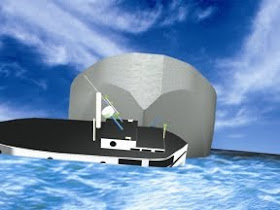 Excerpt from U.S. Coast Guard “Proceedings of the Marine Safety & Security Council” magazine. Click here for Part I and Part II.
Excerpt from U.S. Coast Guard “Proceedings of the Marine Safety & Security Council” magazine. Click here for Part I and Part II.An integrated tug and barge (ITB) transited the waters off Port Washington between 11:30 a.m. and 12:05 p.m. on December 11, 1998. Of the 26 vessels investigated, this was the only one in this area around this time.
The visibility of the ITB operator in the pilothouse is restricted for some distance forward of the barge. Even so, the vessel met the visibility requirements of Title 33 CFR 164.15.
 Contributing to the Casualty
Contributing to the CasualtyLack of visibility from both the ITB and the Linda E most likely contributed to the collision. The window arrangement of the downed vessel, with widely spaced portholes, was not conducive to a wide view of surrounding waters.
It is possible that the sun just off the port bow of the ITB shone directly into the pilothouse and obscured the Linda E. Also, due to the length of the barge, once a small vessel was close off the bow, the tug operator’s view would be obscured, as depicted here.
Additionally, the investigators concluded that the radar on the ITB was not monitored adequately or not used properly. Other contributing factors included the diverted attention of the ITB operator who was standing watch. The mate was performing a non-navigation activity that distracted his attention from activities essential to navigation—like looking out for other vessels.
 The Incident
The IncidentMSC graphic analysis illustrates how the accident may have taken place. Upon collision, the heel of the fishing vessel would have caused rapid downflooding through the submerged large door openings, sinking the vessel within seconds.
It is possible that the crew aboard the ITB neither felt, heard, nor observed the collision. Marks and damage to the barge suggested the collision was brief and light.
Even if the collision were more severe, the resulting change in velocity of the barge would not have been detectable. Noise from generators and activity on the barge may have prevented hearing a collision, and the Linda E most likely sank so quickly that it did not pass far enough aft to be seen by anyone on deck of the barge or in the pilothouse of the tug.
In part IV we will examine the lessons learned from this incident.
For more information:
Full article is available at www.uscg.mil/proceedings. Click on “archives” and “2006 Volume 63, Number 2” (Summer 2006).
Subscribe online at http://www.uscg.mil/proceedings/subscribe.asp.
Direct requests for print copies of this edition to: HQS-DG-NMCProceedings@uscg.mil.
No comments:
Post a Comment
Comment Policy
We welcome your comments on postings at all Coast Guard sites/journals. These are sponsored by the U.S. Coast Guard to provide a forum to talk about our work providing maritime safety, security and stewardship for the American people to secure the homeland, save lives and property, protect the environment, and promote economic prosperity.
Please note: Anonymous comments have been disabled for this journal. It is preferred that you use your real name when posting a comment. WE WILL POST THE NAME YOU ENTER WHEN YOU SUBMIT YOUR COMMENT. Also, you are welcome to use Open ID or other user technologies that may be available.
All comments submitted are moderated and will be reviewed before posting. The Coast Guard retains the discretion to determine which comments it will post and which it will not. We expect all contributors to be respectful. We will not post comments that contain personal attacks of any kind; refer to Coast Guard or other employees by name; contain offensive terms that target specific ethnic or racial groups, or contain vulgar language. We will also not post comments that are spam, are clearly off topic or that promote services or products.
We will make our best effort to promptly post those comments that are consistent with the Comment Policy, but given the need to manage federal resources, moderating and posting of comments will usually occur only during regular business hours, Monday through Friday. Comments submitted outside of business hours will be read and posted as quickly as possible.